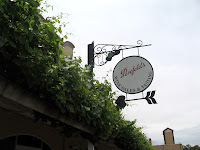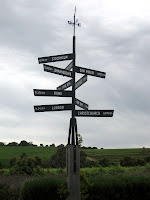
My brother had come to stay the night with us at the University House because we would be leaving for Sydney the following day. Thankfully, I had my earplugs with me. On the morning of the 11th of December, everyone got dressed & packed up their suitcases. Before we carried them down 4 flights of stairs, we had our last buffet breakfast at The Fellows Bar & Café. As always, the food & drinks were delicious. After all of our suitcases were on the ground floor, we checked our email in the computer room while waiting for the taxi to take us to the bus terminal. The ride to the bus terminal was uneventful except for when the taxi driver jokingly suggested that we were moving to Australia because of the amount of suitcases we were carrying.
While my parents & older brother waited for their bus to Sydney, I took a bus to the airport to catch my flight to Sydney. During the planning stages of the vacation, my parents had bought me a Virgin Blue Air Pass that offers 3 cheap flights anywhere in Australia, New Zealand, Pacific Islands, and Southern Asia. At this point in the trip, I was the only one in the family who hadn’t used up their Air Pass meaning I had the luxury of taking a one hour flight to Sydney while the rest of the family labored on a 3 hour bus ride. Lucky me.
Since I arrived early at the airport terminal I had to wait some time before I could check in and drop off my suitcase. Getting through security wasn’t a problem considering that this was the umpteenth time I was doing the same screening procedure. After another 90 minutes of waiting, I boarded the plane and it took off into the clear blue sky, heading towards the largest city in Australia.
Sydney was Australia’s first European settlement, established as a penal colony in 1788 by Arthur Phillip, commodore of the First British Fleet. Before the arrival of the Europeans in 1770, indigenous Australians had lived in the area for 30,000 years. The indigenous tribes resisted early European settlement due to the highly contagious diseases (ie. smallpox) that Europeans brought with them, which led to the deaths of thousands of Aborigines. Nevertheless, the settlement grew during the 1800s, officially becoming a city in 1842, and seeing a spike in population during the 1850s Gold Rushes. By the early 20th century, the population was well over 1 million people and today, is around 4.5 million, spread across 12,144 square kilometers of land. The city has also been the host of the 1938 British Empire Games, the 2000 Summer Olympics, and the 2003 Rugby World Cup.
The plane safely touched down at the Sydney Airport and parked at the domestic terminal. The international terminal is located on the other side of the airfield. After picking up my suitcase, I hopped on the subway to the city centre. Tickets cost about $14 AUD. While travelling theCityRail train to the Museum station, memories of my previous visit came flooding back in my mind. After stepping off the train, I walked only a short distance to the hotel where my family would be staying. The Hyde Park Inn is a 4 star hotel located on Elizabeth Street, just steps away from the ANZAC War Memorial. I waited in the hotel’s lobby for about 15 minutes before my family showed up. Our room was on the 12th floor, with 3 beds, small kitchen, tv, closet, washroom, and balcony. We had a clear view of the war memorial and the sunbathers lying around it.
For dinner we dined at the Mazzaro Restaurant that just happened to be right next to the hotel. Mazzaro is a formal restaurant that specializes in contemporary Mediterranean cuisine so wear something nice. We were welcomed by a greeter who was also the owner. Judging from his character, I imagine that he watches the doors like a hawk and swoops in the second people walk in. Upon being seated, we were greeted by a waiter who handed out the menus & the wine list. You know when a restaurant is formal when most of the wines on the wine list can only be ordered by the bottle. Customers can choose between two courses, three courses, or an a la carte meal.
Unfortunately, I can’t remember that far back so I can’t specifically say what we ate and drank. What I do remember is that the food & wine were of good quality but the prices are expensive. I also remember a large group of people (possibly a business party) entering during the course of our meal and taking up a section of the restaurant across from us. They could have been quieter but I guess they were celebrating something big.

















































